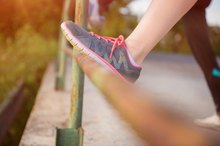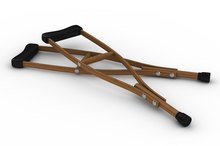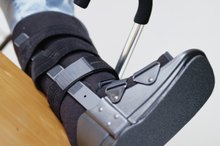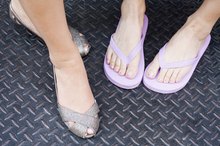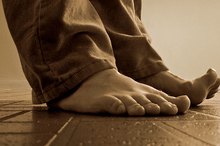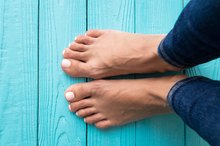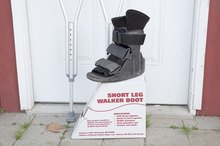How to Recover from Hammertoe and Bunion Surgery
Hammertoe deformities and bunions that continue to cause pain despite noninvasive treatments often require surgical correction. Your doctor will determine which of the many types of surgical procedures to correct these foot problems is best suited to your situation. Your participation in the recovery process from hammertoe and bunion surgery aids in the healing and promotes a good, long-term outcome 5.
If you are experiencing serious medical symptoms, seek emergency treatment immediately.
Control Swelling and Pain
Keep your foot elevated on pillows to minimize swelling. This is especially important in the first few postoperative days when swelling is most significant. Put a second pillow under your knee to make the elevation of your foot more comfortable. Continue to elevate your foot until swelling subsides or your doctor advises you that it is safe to stop. Controlling swelling in your foot reduces pain and promotes healing.
Weight Bearing Immediately After Bunionectomy
Learn More
Apply an ice pack to your foot when you get home from your procedure. Wrap the ice pack in a towel to prevent your bandage from getting wet. Keep ice on your foot during your waking hours for the first few days after your surgery to control pain and reduce swelling.
Take over-the-counter or prescription pain medication according to your doctor's instructions. The level of pain after hammertoe and bunion surgery varies, depending on the procedures performed and your pain threshold 5. Keeping your foot elevated and iced typically reduces the amount of pain medication you need to remain comfortable.
- Keep your foot elevated on pillows to minimize swelling.
- Keep ice on your foot during your waking hours for the first few days after your surgery to control pain and reduce swelling.
Wound Care
Foot Pain When First Walking in the Morning
Learn More
Keep the bandage on your foot clean and dry. Follow your surgeon's instructions if you need to perform any wound care at home. Commonly, your doctor will see you in the office for your first bandage change.
Do not get your foot wet in the bath or shower until your doctor advises you that it is safe to do so. Keeping your incision dry promotes healing and helps prevent the development of infection.
Take any antibiotics your doctor prescribes as directed; be sure to take all of the medicine. Do not be alarmed if your doctor does not prescribe antibiotics, because they are not necessary in many cases.
Go to your doctor's office as scheduled to have your stitches removed; this typically occurs one to two weeks after your surgery. Early or late removal of your stitches may interfere with your recovery.
Wear the postoperative footwear as prescribed by your doctor. You will likely return home after your operation wearing a surgical boot that supports your foot and keeps your toes in the proper alignment.
Do not resume wearing your usual shoes until your surgeon clears you to do so. Wearing the wrong footwear can jeopardize the long-term success of your surgery.
- Keep the bandage on your foot clean and dry.
- Follow your surgeon's instructions if you need to perform any wound care at home.
Weight Bearing and Resuming Activities
Although you will probably be able to walk immediately following your surgery, keep your weight on your heel and off of your toes, according to your doctor's instructions after your surgery.
If your doctor provides you with a walker, crutches or a cane to help you walk, use these mobility aids as prescribed. Do not resume full weight bearing on the foot that underwent surgery until your doctor advises you that it is safe.
Be patient and follow your doctor's instructions regarding the resumption of your usual activities. The healing process for bunion and hammertoe surgery continues for 3 to 12 months after surgery 5. Avoid the temptation to participate in strenuous activities before your doctor determines it is safe for you. Straining your foot soon after your surgery may lead to a poor outcome and continued pain.
Tips
You may return to work when your doctor clears you to do so. You may be able to return to work a few days after your surgery if your work is primarily sedentary. Your return to work will be delayed if your job requires prolonged standing, walking or more strenuous activity.
Eat a healthful, well-balanced diet to aid in your recovery. Lean protein, fruit and vegetables are particularly important to include in your diet in the weeks following your surgery.
Poorly fitting shoes and high heels contribute to the development of hammertoe deformities and bunions. As you heal from your surgery, talk with your doctor about what types of shoes to wear to reduce the chance of a recurrence of these painful foot problems.
Performing prescribed foot, toe and ankle exercises may speed your recovery after hammertoe and bunion surgery. However, do not begin an exercise program without first discussing it with your doctor.
Warnings
Contact your doctor urgently if you develop a fever, bleed more than a few drops from your incision, notice wound drainage on your bandage or develop redness and warmth at the surgical site.
Protect your foot from bumping, especially if you have a temporary metal pin holding the bones in place. Call your doctor right away if you accidentally displace the pin.
- Although you will probably be able to walk immediately following your surgery, keep your weight on your heel and off of your toes, according to your doctor's instructions after your surgery.
- Avoid the temptation to participate in strenuous activities before your doctor determines it is safe for you.
Related Articles
References
- American Orthopaedic Foot and Ankle Society: Bunions
- American Orthopaedic Foot and Ankle Society: Hammer Toe
- American Academy of Orthopaedic Surgeons: Bunion Surgery
- Joshua Kaye, DPM: Timeline for Bunion Surgery
- Emory Healthcare: Care Plan: Bunion and Hammertoe Surgery
- Premier Podiatry: Hammer Toe
- U. S. National Library of Medicine. Hammer toe. MedlinePlus.
- American Academy of Orthopaedic Surgeons. Hammer toe.
- Cleveland Clinic. When is surgery necessary for hammertoe?
- American Orthopaedic Foot & Ankle Society. Hammertoe surgery.
- Harvard Health Publishing. Hammertoe.
- Encyclopedia Britannica. Hammertoe.
- U.S. National Library of Medicine. Tests and visits before surgery. MedlinePlus.
- American Orthopaedic Foot & Ankle Society. How to prepare for foot or ankle surgery: Before surgery.
- American Orthopaedic Foot & Ankle Society. How to prepare for foot or ankle surgery: Day of surgery.
- American Orthopaedic Foot & Ankle Society. Flexor to Extensor Tendon Transfer.
- U.S. National Library of Medicine. Hammer toe repair – discharge. MedlinePlus.
Tips
- You may return to work when your doctor clears you to do so. You may be able to return to work a few days after your surgery if your work is primarily sedentary. Your return to work will be delayed if your job requires prolonged standing, walking or more strenuous activity.
- Eat a healthful, well-balanced diet to aid in your recovery. Lean protein, fruit and vegetables are particularly important to include in your diet in the weeks following your surgery.
- Poorly fitting shoes and high heels contribute to the development of hammertoe deformities and bunions. As you heal from your surgery, talk with your doctor about what types of shoes to wear to reduce the chance of a recurrence of these painful foot problems.
- Performing prescribed foot, toe and ankle exercises may speed your recovery after hammertoe and bunion surgery. However, do not begin an exercise program without first discussing it with your doctor.
Warnings
- Contact your doctor urgently if you develop a fever, bleed more than a few drops from your incision, notice wound drainage on your bandage or develop redness and warmth at the surgical site.
- Protect your foot from bumping, especially if you have a temporary metal pin holding the bones in place. Call your doctor right away if you accidentally displace the pin.
Writer Bio
This article was written by the CareerTrend team, copy edited and fact checked through a multi-point auditing system, in efforts to ensure our readers only receive the best information. To submit your questions or ideas, or to simply learn more about CareerTrend, contact us [here](http://careertrend.com/about-us).


